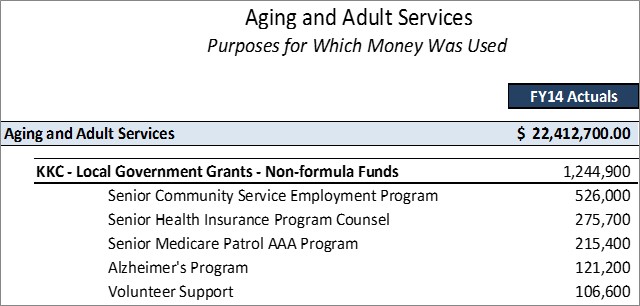The division also administers programs that have different funding sources and, as a result, do not use the funding formulas established by the Older Americans Act. Each program has its own funds distribution method for allocation to the AAAs and other subcontractors.
During the 2015 General Session, the Legislature appropriated for Fiscal Year 2016, $1,215,500 from all sources for Non-Formula Funds. This is a 21.5 percent reduction from Fiscal Year 2015 revised estimated amounts from all sources. The total includes $121,000 from the General/Education Funds, a change of 0 percent from revised Fiscal Year 2015 estimates.
In addition to statewide compensation and internal service fund cost increases, the following appropriation adjustments were made during the 2015 General Session:
For the most recent completed fiscal year, the following information represents the purposes for which the money was used:

With regard to the Domestic Violencearea of Local Government Grants - Non-formula Funds, the distribution of funds is "based on the federal poverty level of 100%; population; demographics, geographic area, race/ethnicity and frailty (ADLs and IADLs)." UCA 62A-3-108 establishes critieria for distribution and otherwise governs the distribution of these funds.


Regarding the positive trend greater than 5% in the insurance program enrollment from the Aging Non Formula program performance measures, the agency states, "Greater outreach efforts have resulted in an increase in seniors participating in SHIP enrollment."
Regarding the negative trend greater than 5% in the number of eligible seniors placed in regular employment from the Aging Non Formula program performance measures, the agency states, "According to SCSEP final reports and the last three year reports, Easter Seals has only one year of not achieving the DOL goal and we have been consistent. In Program year 2013: Easter Seals RM had 238 authorized slots, 261 participants were enrolled in the program, with 58 leaving for employment (33.3% with a goal with the DOL of 46.1%). Utah SCSEP had 59 authorized slots, 59 participants were enrolled in the program, with 19 leaving for employment (68.4% with a goal with the DOL of 56%). In Program year 2012: Easter Seals RM had 228 authorized slots, 244 participants were enrolled in the program, with 52 leaving for employment (42.7% with a goal with the DOL of 36.2%). Utah SCSEP had 61 authorized slots, 61 participants were enrolled in the program, with 17 leaving for employment (62.1% with a goal with the DOL of 55%). In Program year 2011: Easter Seals RM had 240 authorized slots, 240 participants were enrolled in the program, with 66 leaving for employment (34.9% with a goal with the DOL of 35%). Utah SCSEP had 62 authorized slots, 62 participants were enrolled in the program, with 19 leaving for employment (66.7% with a goal with the DOL of 45.2%."
These programs include:
- Volunteer Support: This is a state funded program to provide volunteer opportunities for senior citizens. These volunteer opportunities include socialization for seniors that are homebound or in nursing homes, tutoring school children, working with juvenile offenders, and staffing service agencies. The state office provides state funds to assist volunteers with their transportation costs.
- Senior Health Insurance Information Program (SHIP): This federal program operates in every county in Utah and assists seniors in understanding the complexities of the various Medicare and Medicare supplement programs as well as the Medicaid program and long-term care products.
- Employment Services (SCSEP): This federally funded program subsidizes part-time employment and training for low-income seniors.
- Advocacy Information: The division provides information for inclusion into newsletters specifically targeted to the senior population, such as Utah Spirit Magazine. These publications provide information on available services as well as senior issues.
COBI contains unaudited data as presented to the Legislature by state agencies at the time of publication. For audited financial data see the State of Utah's Comprehensive Annual Financial Reports.